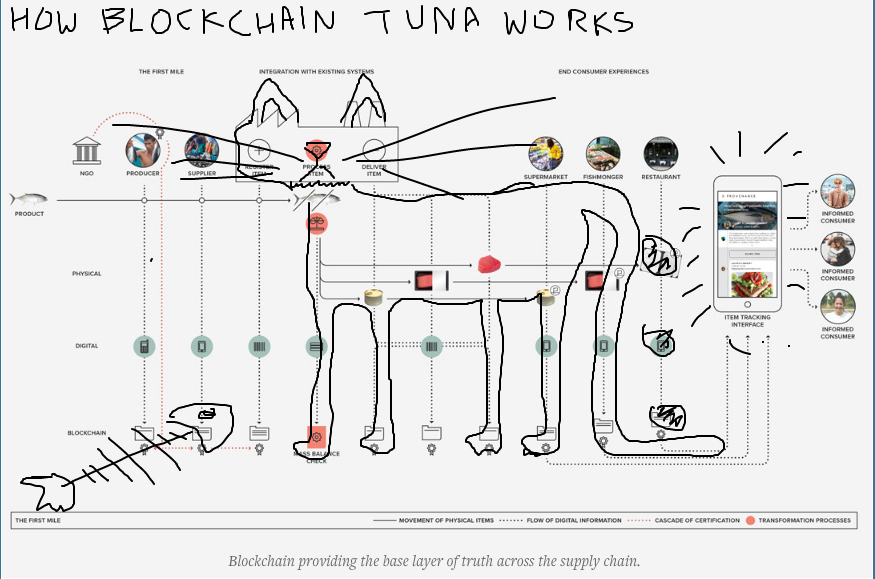This:

You may recall that some years ago the very connected (Tiger Management founder Julian Robertson's Robertson Foundation, Geneva-based British billionaire Alan Parker's Oak Foundation, Bloomberg Philanthropies, Rockefeller Bros. et al) Oceana issued a report that huge amounts of seafood were not what they purported to be.
Specifically in New York City they found, via DNA analysis, "39 percent of the 142 seafood samples collected and DNA tested from grocery stores, restaurants and sushi venues were mislabeled."
Interestingly, Oceana's approach is a bit different from many conservancy organizations, highlighted by the greeting on their homepage:
Restoring the ocean could feed 1 billion people a healthy seafood meal every day.They understand the oceans are a resource whose use can be optimized.
Since the report came out (discussed here at Forbes, Dec. 2012) we've been paying attention to efforts to track fishy provenance, granted that this is more out of taste considerations than ecology, but paying attention nonetheless..
Additionally, there are other concerns.
One of the fish
Be wary.
Seriously, be wary*
Here's the latest on chain-of-evidence, from FT Alphaville:
Tuna blockchains and Chilean Seabass
This is a schematic from a London-based company called Provenance which is trying to “commit tuna” to the Ethereum blockchain. It comes via a report with a handy public link:...You'll have to follow the link to see the significance of the graphical stylings.
...There’s also some grandiose prose about the importance of transparency in supply chains and the need for every bit of the production process to be digitised and registered from the point of origin on a blockchain. It’s the usual blockchain rhetoric like this:
The application links identity, location, material attributes, certifications and audit information with a specific item or batch ID. The data is stored in an immutable, decentralized, globally-auditable format which protects identities by default, allowing for secure data verification.But also stuff like this:
Standards allow unconnected systems to communicate using the same language, structures and identifiers. GS1, for example, manages a closed set of global standards for most supply chain concepts such as barcodes and shipping container codes. There are, however, very few standards for identifying individual instances of products or their history. We are working to develop this as a community-owned, open standard.And:
In short, the blockchain provides an audit layer sitting on top of an existing ERP or other data management system – like Tally-O. This allows data to be shared and mass balancing of certified product to be conducted between two separate factories. Even more, it allows that data to be joined with data collected from the first mile in a trustworthy way – providing a true end-to-end record without the need to change existing interfaces to data capture.Which begs the question is this really about blockchain technology or the formation of global best-practice standards for supply chain management and product sourcing? Because if it’s the latter, why blockchain?
The very amiable and sincere founder of Provenance is Jessi Baker. When we spoke to her on the phone she insisted that “double-spending” in supply chains is a much bigger problem than most people appreciate.
“The problem is that along the supply chain these [certificates] are being duplicated or substituted and nobody has a global view of what’s going on,” said Baker. “Our argument is that there can’t be one person to account for all of that data. A blockchain enables the fact that it doesn’t need a central broker.”
But before we outline our concerns about that idea, if the tuna blockchain was a Rorschach test might it conjure up thoughts like this?...MORE
In the meantime, there will be a time and a plaice for blockchain, we'll see if this is it.
Carp diem.
Related:
How to Break a Market Corner: Breeding Breakthrough Helps Sushi Baron Create Sustainable Tuna
*From the Monterey Fish Market:
GemplylotoxinAmong the six 'Key findings' in the Executive Summary of the Oceana report:
Members of the Gempoylidae, or snake mackerel family, contain indigestible waxy esters in their fatty tissues similar to those found in Olestra, and these esters have powerful laxative properties that affect people to varying degrees.Escolar and oilfish caught in the South Pacific and Gulf of Mexico are two such fish, and are quite delicious, popular menu items. Freezing and cooking won't inactivate gempylotoxins, so eating no more than 3-5 ounce servings or avoiding it is the only solution.Symptoms of this illness are illusive, sudden, and without warning. You can be affected at any time or in the most inappropriate place, and the results can be quite embarrassing, not to mention unhygienic.
- 94 percent of the “white tuna” was not tuna at all, but escolar, a snake mackerel that has a toxin with purgative effects for people who eat more than a small amount of the fish.